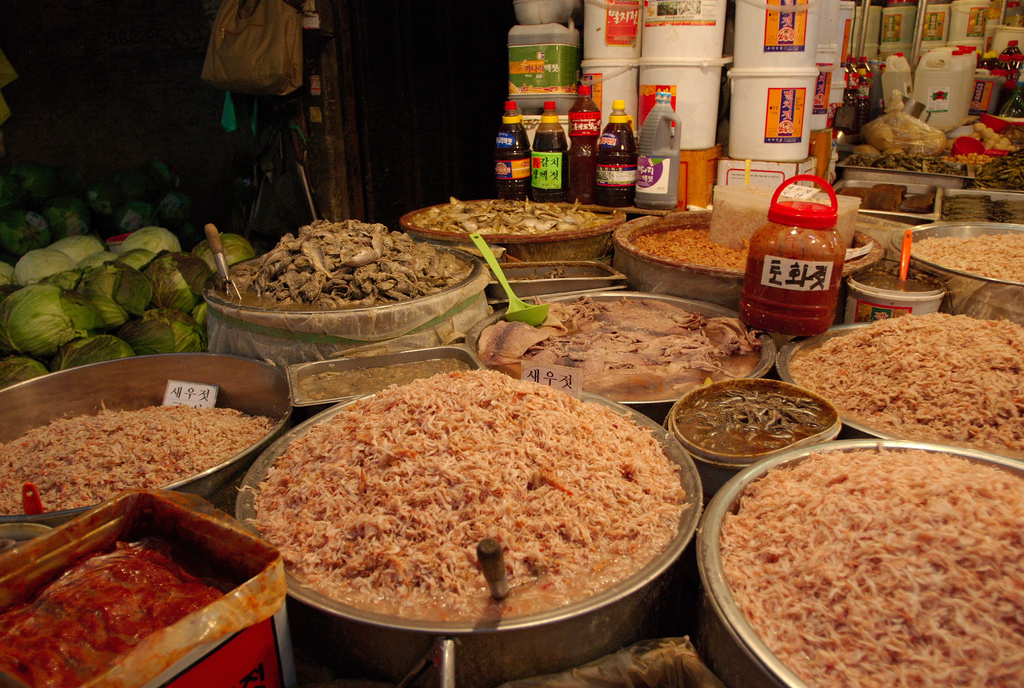In Korean cuisine all the dishes are served at the same time. A typical meal normally includes rice, soup, and several side dishes, the number of which vary. Traditionally, lower classes had three side dishes, while royal families would have twelve.
In Korea, like in neighboring China and Japan, people eat with chopsticks. However, a spoon is used more often in Korea, especially when soups are served. Formal rules have developed for table setting, which can vary depending on whether a noodle or meat dish is served.
Food is a very important part of Korea culture, and Koreans pay great attention to the way in which food is served.
KINDS OF TRADITIONAL KOREAN FOODS
Boiled rice is the staple food for Koreans; it is eaten with almost every meal. In Korea people eat short-grained rice, as apposed to the long- grained Indian rice. Korean rice is often sticky in texture, and sometimes it is combined with beans, chestnuts, sorghum, red beans, barley or other cereals for added flavor and nutrition. Juk (porridge) is a light meal, which is highly nutritious. Juk is often made with rice, to which abalone, ginseng, pine nuts, vegetables, chicken, or bean sprouts can be added. As well as rice porridge, red bean porridge and pumpkin porridge are also delicious.
2. Guk (soup)
Korean meals traditionally consist of a soup served with rice. The soup can be made from vegetables, meat, fish, shellfish, seaweed, or beef bones.
3. Jjigae (stew)
Jjigae is similar to guk but is thicker and has a stronger taste. The most famousjjigae (doenjang-jjigae )is made from preserved soy bean paste. Jjigae is usually spicy and served piping hot in a heated stone bowl.
4. Jjim and Jorim (simmered meat or fish)
Jjim and jorim are similar dishes. Meat and fish are prepared with vegetables and soaked in soy bean sauce. The ingredients are then slowly boiled over a low heat.
5. Namul (vegetables or wild greens)
Namul consists of vegetables of wild greens, which have been slightly boiled or fried, and mixed with salt, soy sauce, sesame salt, sesame oil, garlic, onions, and other spices.
6. Jeotgal (seafood fermented in salt)
Jeotgal is a very salty food made from naturally preserved fish, shellfish, shrimp, oysters, fish roe, intestines and other ingredients.
7. Gui (broiled/barbecued dishes)
When cooking gui, marinated meats are barbecued over a charcoal fire. The most popular meats of this type are bulgogiand galbi. There are also many fish dishes which are cooked this way.
8. Jeon (pan-fried dishes)
Jeon is a kind of Korean pancake. Mushrooms, pumpkin, slices of dried fish, oysters, unripened red peppers, meat, or other ingredients are mixed with salt and black pepper, dipped in flour and egg and then fried in oil
9. Mandu (dumpling)
Mandu are Korean dumplings, which are stuffed with beef, mushrooms, stir-fried zucchini, and mungbean sprouts. Chicken, fish or kimchi are sometimes used instead of beef.









Gulbi means ribs. Chicken portions of marinated chicken are stir-fried with vegetables and tacos. Pork or beef ribs are cooked on a metal plate over charcoal in the center of the table.
ReplyDelete